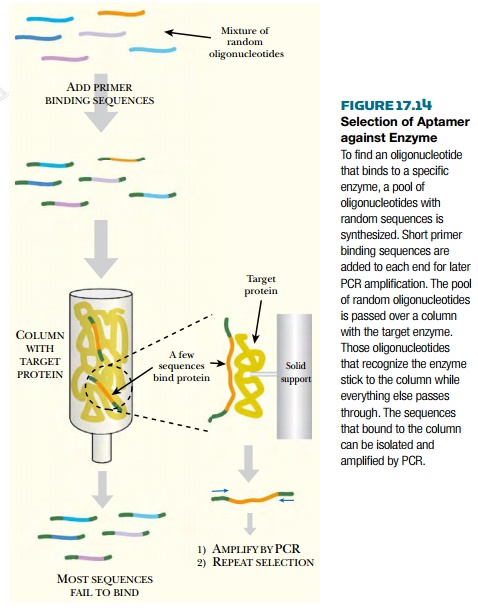Chapter: Biotechnology Applying the Genetic Revolution: Gene Therapy
Aptamers-Blocking Proteins with RNA
APTAMERS-BLOCKING
PROTEINS WITH RNA
In theory, antisense
oligonucleotides could also disrupt gene expression by preventing transcription
factors from binding to DNA. Many DNA binding proteins have relatively short
recognition sequences; therefore, short oligonucleotides could block the DNA
binding site of the protein. Without is an active transcription factor, the
target gene would not be transcribed.
In principle, an artificial
oligonucleotide could be designed to fit into a binding site of any shape. Even
if an enzyme does not normally bind nucleic acids, an oligonucleotide could be
designed that would block the active site of the protein. Such oligonucleotides
do not correspond to natural nucleic acid sequences and are known as aptamers. This procedure has been
demonstrated experimentally for the enzyme thrombin,
a protease involved in the blood clotting cascade. The antithrombin aptamer is short-lived because it is degraded
rapidly in vivo. It might perhaps be
useful as an anticlotting agent, such as during bypass surgery.
Aptamers may be made by a
combination of molecular selection and PCR amplification. Random
oligonucleotides (of 50 or 60 bases) are artificially synthesized by
solid-state synthesis, using a mixture of all four bases at each step. The pool
of random sequences is then ligated at each end to primer binding sequences
(approximately 20 bases long). The mixture is poured through a column to which
the target protein is attached (Fig. 17.14). Some oligonucleotides will bind to
the protein and are therefore retained by the column. These are dissociated and
then amplified by PCR. The bound oligonucleotides will be a mixture, some of
which bind weakly and some strongly. Therefore the binding and PCR steps are
repeated two or three times to select oligonucleotides with high binding
affinity.

Recently, pegaptanib
(Macugen; from Eyetech Pharmaceuticals, Pfizer, New York) has been approved for
treatment of blindness due to age-related macular degeneration. Pegaptanib is
an aptamer that inhibits the action of
an isoform of vascular endothelial growth factor (VEGF) that is responsible for
abnormal vascularization of the eyes. Binding of pegaptanib to VEGF prevents
VEGF from binding to its receptor.
Related Topics